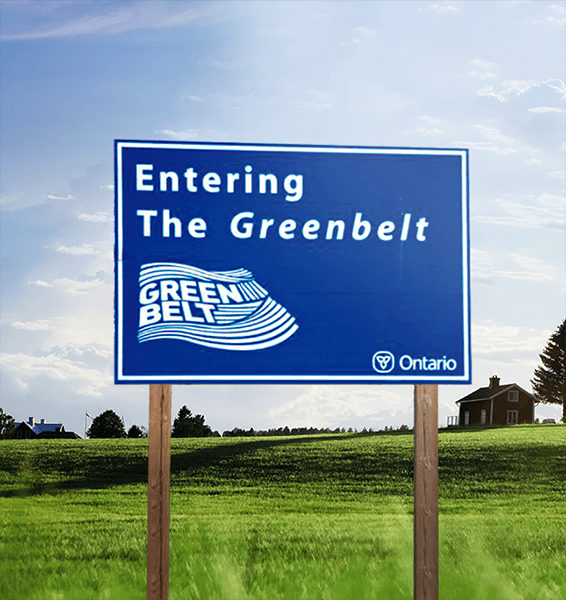This fun cooperative game helps students understand threats to biodiversity and the importance of conservation areas such as a Greenbelt in protecting biodiversity.

Grade level: 4-6
Learning Objective:
– Recognize the importance of conservation areas in protecting biodiversity
In this activity, students will:
– Play a game which demonstrates threats to natural habitats
– Reflect on the benefits of conservation areas
– Consider how human activity affects nature
Materials:
- Deck of playing cards
- Hula-hoops (There should be less hula-hoops than students)
- Greenbelt Game Animal Cards (one card per student)
- Greenbelt Game Threats
- Greenbelt Game Action Poster
A Greenbelt is an area of undeveloped land surrounding an urban area. This land could be wild or agricultural and it is protected from development and construction. The Ontario Greenbelt is the largest in the world!
The Greenbelt helps protect animal habitats and retain biodiversity. In this game, each student is one of 6 different animals living in the Greenbelt. To win the game, at least one representative of each animal must be left in the greenbelt at the end of 15 minutes.
The Greenbelt is made up of hula-hoops arranged on the ground. Students can move from hula-hoop to hula-hoop as long as the hula-hoops are touching and there is room for them to fit in the hula-hoop.
Playing cards are drawn at random. If it is a red suit, it is a “threat” and a piece of the Greenbelt will be removed. If it is a black suit, it is an “action” card that can counteract a future threat.
Will your class survive 15 minutes?
Set up
1. This game can be played inside or outside. Arrange hula-hoops on the floor or the ground, making interesting patches and corridors, making sure they are always touching at least one other hula-hoop, for example:

2. Shuffle the deck of playing cards and place it in on a table or a flat surface.
3. Display the Green Belt Action Poster
Instructions
1. Ask the students the following questions to activate prior knowledge and fill in any gaps (additional information available in the resource section).
- What is a greenbelt?
- What is urban sprawl?
- Why should we protect green and blue (water) spaces around cities?
- How can we protect green and blue spaces around cities?
2. Tell the students that you are going to play a game that shows why Greenbelts are important and explain the rules.
3. Pass out an “Animal Card” to each student and ask them to remember their animal.
4. Have the students stand in hula-hoops. There should be less hula-hoops than students, so some hula-hoops will have more than one student standing in them.
5. Set a timer for 15 minutes.
6. Start the game by reading the narrative.
7. Play the game as directed.
Discussion
Return to the classroom and have the students discuss some or all of the questions below:
About the game:
- What happened when some sections of the Greenbelt became crowded?
- What happened when the Greenbelt became fragmented?
- Was there ever a time when the class had so many ACTIONs that you could cancel out a lot of THREATs whenever they came up? Give an example of how this can happen in the real world.
- Sometimes we collected a lot of ACTIONs in one suit but not another, so they weren’t useful in the circumstance. Give an example of how this can happen in the real world. How do you know what actions are actually useful?
- Why do habitats have limits to the number of plants and animals that they can support?
Going further:
- At first, everyone could reach the Greenbelt, but later it was harder. In the real world we can ignore problems for a long time. How do you show people problems before they get too bad?
- What do you think would happen if the Greenbelt rules were removed?
- How would you describe the impact of humans on animal habitats?
- What can we do to help preserve animal habitats?
- How can we as a class teach parents and guardians about the importance of the Greenbelt?
Extension Activity:
Have the students undertake research projects about the animals on their cards.
References
Ontario Greenbelt (Greenbelt Foundation)
Learn about the Greenbelt
https://www.greenbelt.ca/learn
Ontario Greenbelt Map
https://www.greenbelt.ca/maps
The Ontario Greenbelt (video)
https://www.youtube.com/watch?v=BAXCBz2MU5Y
Examples of other Greenbelts and protected corridor initiatives in Canada:
Montreal Greenbelt (Nature Conservancy Canada)
https://www.natureconservancy.ca/en/where-we-work/quebec/featured-projects/montreals-greenbelt/montreals-greenbelt.html
New Brunswick/Nova Scotia Chignecto Isthmus Wildlife Corridor (Nature Conservancy Canada)
https://www.natureconservancy.ca/en/where-we-work/nova-scotia/featured-projects/Chignecto-Isthmus.html
Ottawa Greenbelt (NCC)
https://ncc-ccn.gc.ca/places/greenbelt
Yellowstone to Yukon Conservation Initiative
https://y2y.net/about/vision-mission/
